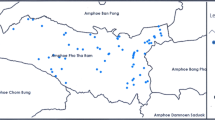Abstract
Kinmen is located in the southwest of Mainland China. Groundwater supplies 50% of the domestic water use on the island. Residents of Kinmen drink groundwater over the long term because surface water resources are limited. Nitrate–N pollution is found and distributed primarily in the western part of groundwater aquifer whereas saline groundwater is distributed to the northeastern Kinmen. This work applied the DRASTIC model to construct the vulnerability map of Kinmen groundwater. MT3D was then used to evaluate the contamination potential of nitrate–N. The health risk associated with the ingestion of nitrate–N contaminated groundwater is also assessed. The results from DRASTIC model showed that the upland crop and grass land have high contamination potential, whereas the forest, reservoir and housing land have low contamination potential. The calibrated MT3D model inversely determined the high strength sources (0.09–2.74 kg/m2/year) of nitrate contaminant located in the west to the north west area and required 2–5 years travel time to reach the monitoring wells. Simulated results of MT3D also showed that both the continuous and instantaneous contaminant sources of nitrate–N release may cause serious to moderate nitrate contamination in the western Kinmen and jeopardize the domestic use of groundwater. The chronic health hazard quotient (HQ) associated with the potential non-carcinogenic risk of drinking nitrate–N contaminated groundwater showed that the assessed 95th percentile of HQ is 2.74, indicating that exposure to waterborne nitrate poses a potential non-cancer risk to the residents of the island. Corrective measures, including protecting groundwater recharge zones and reducing the number of agricultural and non-agricultural nitrogen sources that enters the aquifer, should be implemented especially in the western part of Kinmen to assure a sustainable use of groundwater resources.







Similar content being viewed by others
References
Chen, P. Y., Wang, M. K., Yang, D. S., & Chang, S. S. (2004). Kaolin minerals from Chinmen Island (Quemoy). Clays and Clay Minerals, 52(1), 130–137.
Chow, V. T., Maidment, D. R., & Mays, L. W. (1988). Applied hydrology (pp. 396 and 498). New York: McGraw-Hill.
Coss, A., Cantor, K. P., Reif, J. S., Lynch, C. F., & Ward, M. H. (2004). Pancreatic cancer and drinking water and dietary sources of nitrate and nitrite. American Journal of Epidemiology, 159(7), 693–701.
Fan, A. M., Willhite, C. C., & Book, S. A. (1987). Evaluation of the nitrate drinking water standard with reference to infant methemoglobinemia and potential reproductive toxicity. Regulatory Toxicology and Pharmacology, 7(2), 135–148.
Fewtrell, L. (2004). Drinking-water nitrate, methemoglobinemia, and global burden of disease: A discussion. Environmental Health Perspectives, 112(14), 1371–1374.
Freeze, R. A., & Cherry, J. A. (1979). Groundwater (pp. 413–416). New Jersey, USA: Prentice Hall.
Gupta, S. K., Gupta, R. C., Gupta, A. B., Seth, A. K., Bassin, J. K., & Gupta, A. (2000). Recurrent acute respiratory tract infections in areas with high nitrate concentrations in drinking water. Environmental Health Perspectives, 108(4), 363–366.
Harbaugh, A. W., & McDonald, M. G. (1996). User’s documentation for MODFLOW-96, an update to the U.S. Geological Survey modular finite-difference ground-water flow model, Open-File Report, 96-485, US Geological Survey.
Kinmen Water Plant. (2004). Annual report of water plant in 2004. Kinmen: Kinmen Water Plant.
Knobeloch, L., Salna, B., Hogan, A., Postle, J., & Anderson, H. (2000). Blue babies and nitrate-contaminated well water. Environmental Health Perspectives, 108(7), 675–678.
Liu, C. W., Lin, C. M., Jang, C. S., Chen, C. P., Chang, J. F., Fan, C. C., et al. (2006). Sustainable groundwater management in Kinmen Island. Hydrological Processes, 20, 4363–4372.
Liu, C. W., Jang, C. S., Chen, C. P., Lin, C. N., & Lou, K. L. (2008). Characterization of groundwater quality in Kinmen island using multivariate analysis and geochemical modeling. Hydrological Processes, 22, 376–383.
Mineral Resources Survey. (1962). Drilling report of Kinmen soil. Annual report, Taipei, Taiwan, pp. 55–75.
NRC (National Research Council). (1993). Ground water vulnerability assessment: Predictive relative contamination potential under conditions of uncertainty (pp. 42–63). Washington, DC: National Academy Press.
Rechang Consulting Company. (2002). Setup groundwater observation well in Kinmen. Kinmen: Kinmen County Government.
Rodvang, S. J., & Simpkins, W. W. (2001). Agricultural contaminants in Quaternary aquitards: A review of occurrence and fate in North America. Hydrogeology Journal, 9, 44–59.
Schilling, K. E. (2002). Occurrence and distribution of ammonium in Iowa groundwater. Water Environment Research, 74(2), 177–186.
Taiwan EPA. (1997). Administration regulation of drinking water standard. Environmental Protection Administration, EPA No. 56075.
US EPA. (2002). List of contaminants and their maximum contaminant level (MCLs). EPA 816-F-02-013, US Environmental Protection Agency.
US EPA. (2006). Risk-based concentration table, Region 3. Philadelphia PA, USA: US Environmental Protection Agency.
US EPA (Environmental Protection Agency). (1985). DRASTIC: A standardized system for evaluating ground water pollution potential using hydrological settings. US Environmental Protection Agency.
Ward, M. H., Cantor, K. P., Riley, D., Merkle, S., & Lynch, C. F. (2003). Nitrate in public water supplies and risk of bladder cancer. Epidemiology, 14(2), 183–190.
Zheng, C. (1996). MT3D96 Version DoD_1.5: A modular three-dimensional transport model. USA: Hydrology group, University of Alabama.
Acknowledgments
The authors would like to thank the Water Resources Agency, the Kinmen County Government ant the National Science Council of the Republic of China under Contract Nos NSC 98-3114-E-007-015, NSC 99-NU-E-002-003 for financially supporting this research.
Author information
Authors and Affiliations
Corresponding author
Rights and permissions
About this article
Cite this article
Liu, CW., Lin, CN., Jang, CS. et al. Assessing nitrate contamination and its potential health risk to Kinmen residents. Environ Geochem Health 33, 503–514 (2011). https://doi.org/10.1007/s10653-010-9367-x
Received:
Accepted:
Published:
Issue Date:
DOI: https://doi.org/10.1007/s10653-010-9367-x




